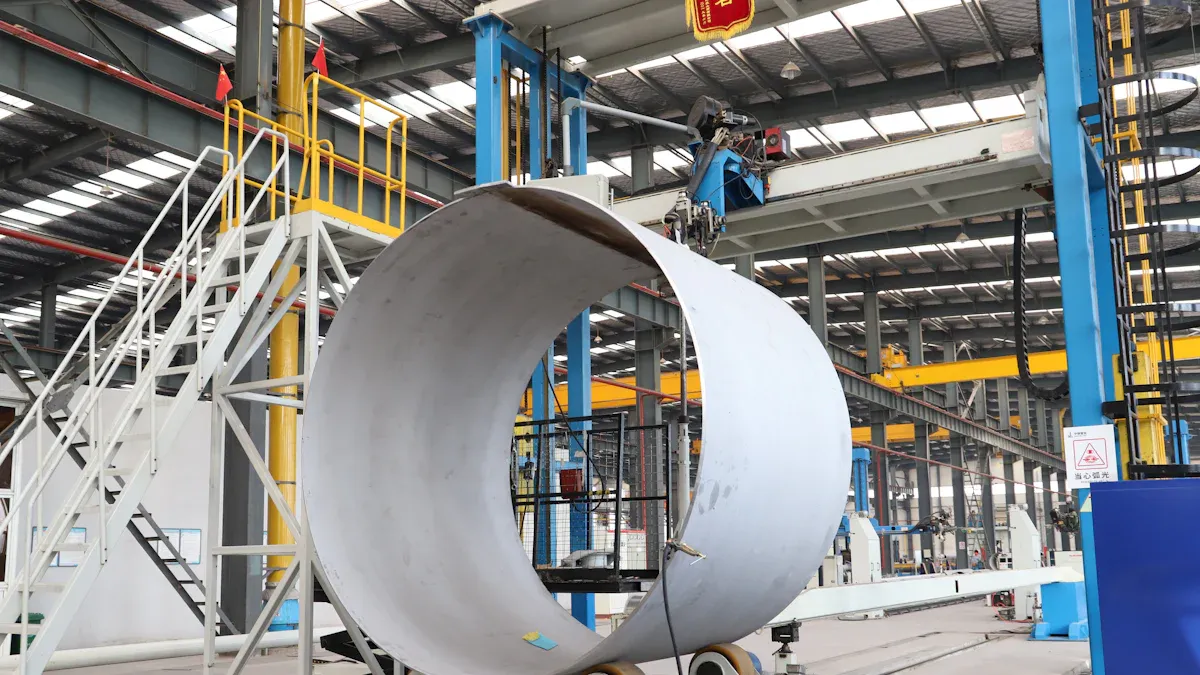How to prevent Nitinol tubing from work hardening during manufacturing

To understand how to prevent Nitinol tubing from work hardening, it is essential to focus on process optimization, precise tool selection, and effective heat treatment. Properly controlling the process reduces local strain and minimizes fatigue damage, which significantly extends the tubing’s lifespan. Research indicates that global strain amplitude and inclusion shape are the primary factors affecting fatigue strength. Applying heat treatment between 400°C and 550°C helps establish the shape memory effect and superelastic properties in superelastic Nitinol strips. By adhering to strict quality control, you can achieve tight dimensional tolerances while preserving superelasticity. Preventing work hardening and maintaining shape memory rely on using high-purity Nitinol and carefully managing each process step. These strategies ensure the tubing remains reliable for critical medical and aerospace applications.
Key Takeaways
Work hardening happens when Nitinol tubing is bent, stretched, or machined too much, making it harder and less flexible.
Using sharp tools, proper cutting speeds, and coolants reduces heat and stress, preventing the tubing from becoming brittle.
Controlling how much the tubing is deformed and applying the right heat treatment restores its special shape memory and superelastic properties.
Careful monitoring of the manufacturing process and following industry standards ensures the tubing stays reliable and meets strict quality requirements.
Proper handling, storage, and tool maintenance protect the tubing from damage before and during manufacturing, keeping it strong and safe for medical and industrial use.
How to Prevent Nitinol Tubing from Work Hardening
Causes of Work Hardening
You need to understand why work hardening happens in nitinol tubing to prevent it during the manufacturing process. Work hardening occurs when you apply repeated force or deformation to the tubing. This often happens during cold working, plastic deformation, or machining. When you bend, stretch, or shape nitinol, the metal’s internal structure changes. Dislocations form inside the metal, making it harder and less flexible.
Recent studies show that cold working and plastic deformation increase the number of dislocations in nitinol tubing. This leads to higher hardness, especially in areas affected by heat and mechanical stress. For example, when you weld or draw nitinol tubing, the grains inside the metal become smaller and more tightly packed. This makes the tubing stronger but also more likely to become brittle if you do not control the process. The hardness can rise from 306 HV in the base metal to 325 HV at the weld interface. These changes can shift the phase transformation temperatures, which affects the shape memory effect and superelasticity of the tubing.
If you do not manage these changes, the tubing may lose its unique properties. Super elastic nitinol strips rely on a delicate balance in their structure. Too much work hardening can ruin this balance and reduce the tubing’s ability to recover its shape or stretch without breaking.
Key Prevention Principles
You can prevent work hardening in nitinol tubing by following several key principles during the manufacturing process. Here are the most effective strategies:
Optimize Cutting Parameters
Use the right cutting speed, feed rate, and depth of cut. Lower speeds and smaller cuts reduce heat and stress on the tubing.
Studies show that using coolant and adjusting these settings can lower cutting temperatures by up to 86.9%. This helps keep the tubing from hardening too much.
When you optimize cutting, you also improve surface finish and extend tool life. This means less stress on the tubing and fewer defects.
Maintain Sharp Tools
Always use sharp, high-quality tools when working with nitinol tubing. Dull tools create more friction and heat, which increases the risk of work hardening.
Replace or sharpen tools regularly to keep the manufacturing process smooth and safe for the tubing.
Control Strain and Deformation
Limit how much you bend or stretch the tubing at each step. Avoid excessive cold working, which can increase dislocation density and make the tubing brittle.
Use precise, gradual shaping methods to protect the super elastic nitinol strips and maintain their superelasticity.
Apply Proper Heat Treatment
Heat treatment is a critical step in nitinol tubing manufacturing. You heat the tubing above its transformation temperature and then cool it quickly. This locks in the shape memory effect and restores superelastic properties.
Annealing helps the tubing recover from work hardening by recrystallizing the metal’s structure. This step is essential for super elastic nitinol strips to perform well in demanding applications.
Monitor and Control the Manufacturing Process
Use quality control systems to track every step of the process. Monitor cutting forces, surface roughness, and temperatures to catch problems early.
Follow industry standards like ASTM F2063. This standard requires strict testing for shape recovery, superelastic strain, endurance, and dimensional tolerances. For example, nitinol tubing can recover up to 4.16% strain and withstand over 600 million cycles without failure. Tight tolerances, such as ±0.005 mm for tubing under 0.3 mm diameter, ensure high performance.
Tip: Always use vacuum-induction melting or vacuum arc re-melting to reduce impurities in the tubing. Combine this with precise tube drawing, optimized dies, and proper lubricants to keep the tubing smooth and strong.
Parameter | Description / Data |
|---|---|
Shape Recovery Strain | About 4.16% recovery strain after deformation |
Superelastic Strain | Up to 7% strain showing superelasticity |
Endurance Requirement | Over 600 million cardiac cycles without failure |
Nickel Release after Passivation | Very low at 75 ppb, showing biocompatibility |
Dimensional Tolerances | ±0.005 mm for tubing under 0.3 mm diameter |
By following these prevention principles, you can learn how to prevent nitinol tubing from work hardening. You will protect the unique properties of super elastic nitinol strips and ensure the tubing meets the highest standards for medical and industrial use. When you control the manufacturing process, use the right tools, and apply proper heat treatment, you keep the tubing reliable and safe for every application.
Nitinol Tubing Manufacturing Process

Handling and Storage
You need to handle nitinol tubing with care from the moment it arrives. Always store tubing in clean, dry areas to prevent contamination and corrosion. Use soft gloves and non-metallic tools when moving super elastic nitinol strips. This keeps the surface free from scratches and particles. Place tubing on padded racks or trays to avoid bending or denting. If you keep tubing organized and protected, you reduce the risk of damage before the manufacturing process begins.
Tip: Label each batch of nitinol tubing clearly. This helps you track material sources and match them to your design needs, as recommended by industry experts.
Cutting and Shaping
Cutting and shaping nitinol tubing requires precision. Use sharp tools and proper cutting fluids to keep the tubing cool and smooth. Modern cutting fluids with high-lubricity esters lower friction and heat, which helps prevent work hardening. High-pressure coolant systems remove chips and extend tool life. You should use PCD dies for their hardness and wear resistance, but remember that they need special care during machining.
Recent studies show that adaptive cutting and shaping methods improve tubing quality. You can achieve clean, burr-free ends and smooth inner surfaces. This reduces contamination risks and improves the fit of super elastic nitinol strips in medical devices. Automated measurement systems help you check tubing dimensions quickly and accurately, saving time and reducing errors.
Precision cutting ensures tubing fits well with small well plates.
Clean ends and smooth surfaces lower the risk of contamination.
Automation improves accuracy and process control.
Cold Working and Drawing
Cold working and drawing shape the tubing and set its final size. You pull super elastic nitinol strips through hard mandrels and dies, often made from PCD, to reach the right diameter and wall thickness. Use proper lubricants to reduce friction and heat during this step. This keeps the tubing strong and flexible.
Cold working changes the structure inside nitinol. When you reduce the thickness by up to 80%, you create tiny domains that help the tubing become superelastic. After drawing, heat treatment restores the tubing’s shape memory and superelastic properties. Studies show that heat-treated, conventionally drawn nitinol tubes have lower hardness and better phase transformation, which means they perform better in demanding uses.
Step | Best Practice | Benefit |
|---|---|---|
Handling/Storage | Use padded racks, soft gloves | Prevents dents and contamination |
Cutting/Shaping | Use sharp tools, cutting fluids, PCD dies | Reduces work hardening, improves finish |
Cold Working/Drawing | Use hard mandrels, proper lubricants | Maintains superelastic properties |
By following these best practices in nitinol tubing manufacturing, you protect the unique qualities of super elastic nitinol strips and ensure reliable performance in every application.
Heat Treatment for Nitinol Tubing

Annealing Methods
You need to use the right heat treatment to keep nitinol tubing strong and flexible. After cold working, you can choose from several annealing methods to set the final shape and properties. Each method helps you control the structure inside the tubing.
Strand Annealing: You pass the tubing through a heated zone on a moving strand. This method works well for long, continuous pieces.
Box Furnace: You place the tubing in a heated box. This method gives you even heating for batches of tubing.
Molten Salt Bath: You dip the tubing into a bath of hot, liquid salt. This method heats the tubing quickly and evenly.
Fluidized Bed: You use hot air and sand to surround the tubing. This method gives you fast and uniform heating.
All these methods help you set the shape memory and superelastic properties of nitinol tubing. Research shows that heat treatment above the austenitic finish temperature can reduce work hardening and improve fatigue life. If you apply heat treatment early in the tubing’s life, you get better results. Localized methods like laser or induction heating also work well for small tubing.
Temperature Control
Precise temperature and time control are critical during heat treatment. If you do not control these factors, you risk damaging the tubing or losing its special properties. You can use hardness testing and advanced microscopes to check if the tubing is soft enough after annealing. X-ray tests help you see changes in the tubing’s structure.
Small errors in temperature can cause big problems. For example, a pyrometer that is not set right can give you a reading that is off by hundreds of degrees.
You need to keep the temperature between 400°C and 550°C. Studies show that 470°C for 30 minutes to 1 hour gives the best results for nitinol tubing. This setting gives you a smooth surface, low nickel release, and strong corrosion resistance.
Always quench the tubing in ice-cold water after heat treatment. This step locks in the shape and properties.
Annealing Temperature | Duration | Result for Tubing Quality |
|---|---|---|
470°C | 30–60 minutes | Best surface, low nickel, strong |
590–610°C | 30–60 minutes | Rough, porous, more nickel |
You should follow ASTM F2063 standards to make sure your nitinol tubing meets all quality checks. Careful heat treatment and temperature control help you get tubing that lasts longer and works better in medical and industrial uses.
Process Control in Tubing Manufacturing
Tool Selection
You must choose the right tools to keep nitinol tubing strong and reliable. Sharp tools help you avoid extra heat and stress during cutting and shaping. When you use dull tools, you risk work hardening and damaging the tubing. Tool steels like D2 or A2 often break down quickly when working with tough metals. Particle metallurgy tool steels, such as Z-Tuff PM®, last much longer and resist breaking. These tools combine hardness and toughness, which helps prevent tool failure and keeps your tubing safe.
Surface treatments, like TiAlN coatings, add extra protection. They reduce wear and stop galling, which can damage the tubing surface. You should also adjust tool design. For example, increasing cutting clearance helps prevent edge fractures. Using metal gainers in draw dies can reduce stretching and stop cracks from forming. Always remember, regular tool maintenance and sharp cutting edges are key for high-quality nitinol tubing.
Note: Passivation makes the tubing surface smoother and more resistant to corrosion. However, it does not stop work hardening. You still need to focus on tool selection and process control.
Process Monitoring
You need to monitor every step when making nitinol tubing. Real-time sensors track forming forces during bending and drawing. These sensors help you catch problems early and keep the tubing within tight limits. Strain gauges and load cells measure force and deformation, giving you instant feedback. Advanced systems use machine learning to predict issues and adjust the process before defects appear.
Industrial control systems, like PID controllers, keep temperatures and speeds steady. Quality management software tracks key measurements and alerts you to changes. You can use statistical process control to watch for trends and fix problems fast. Companies that use these systems see big improvements in tubing quality and fewer defects.
Metric/Aspect | Description/Values |
|---|---|
Surface Roughness (Ra) | 0.21–0.80 µm; smoother surfaces for medical tubing |
SPC | Tracks key measurements for consistency |
Controls temperature, pressure, grit size, and extrusion speed | |
Mechanical Testing | Checks strength, flexibility, and fatigue life |
Industry Standards | ISO 13485, FDA, CE marking for safety and quality |
Dimensional Specifications | Diameter ~1.61 mm, wall 0.1–15 mm, length up to 6000 mm |
You should always follow industry standards to make sure your nitinol tubing meets safety and quality rules. Careful process monitoring helps you deliver tubing that works well in medical and industrial uses.
You can prevent work hardening in nitinol tubing by following key steps. Use precise process control, select the right tools, and apply careful heat treatment.
Additive manufacturing and advanced machining help you keep nitinol’s shape memory and superelasticity.
Surface treatments like electropolishing improve tubing safety and durability.
ISO 13485 certification ensures you test every batch of tubing for size, strength, and biocompatibility.
Consistent best practices help you deliver high-quality nitinol tubing that meets strict medical standards and lasts longer in real-world use.
FAQ
What causes Nitinol tubing to work harden?
You cause work hardening when you bend, stretch, or machine Nitinol tubing. These actions change the metal’s structure. The tubing becomes harder and less flexible. You need to control these steps to keep the tubing strong and elastic.
How can you tell if Nitinol tubing has work hardened?
You can check for work hardening by testing the tubing’s hardness. If the tubing feels stiffer or does not return to its shape, it may have work hardened. You can also use a microscope to look for changes inside the metal.
What is the best way to prevent work hardening during cutting?
You should use sharp tools and the right cutting speed. Coolant helps keep the tubing cool. This reduces heat and stress. You get a smoother cut and protect the tubing’s special properties.
Does heat treatment fix work hardening in Nitinol tubing?
Yes, heat treatment can fix work hardening. You heat the tubing to a set temperature, then cool it quickly. This process restores the tubing’s shape memory and superelasticity.
Why is tool selection important for Nitinol tubing?
You need the right tools to avoid extra heat and damage. Sharp, strong tools cut cleanly and reduce friction. Good tool choice helps you keep the tubing’s unique features and prevents work hardening.
See Also
The Process Behind Manufacturing Nitinol Tubing For Medicine
Nitinol Tubing Transforming The Future Of Medical Devices
The Importance Of Nitinol Tubing In Advanced Medical Use
The Effect Of Cyclic Life Testing On NiTi Tubing Strength
Choosing The Right Nitinol Tubing Supplier For Your Requirements

